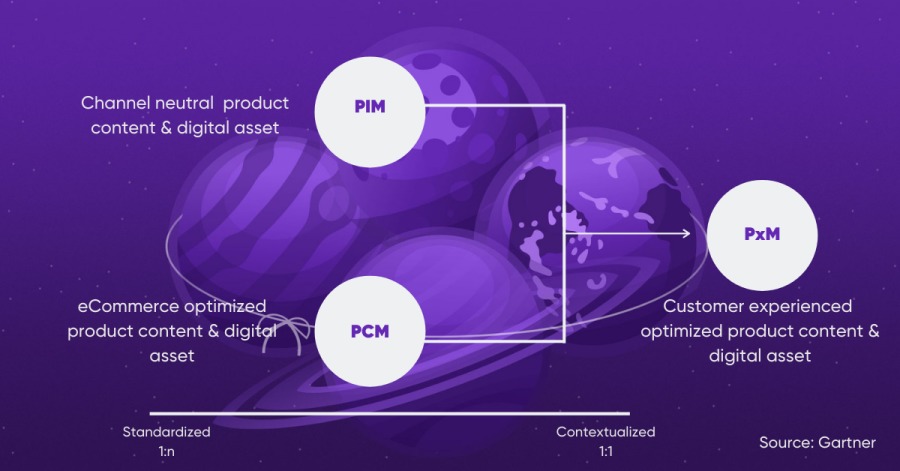What Is Product Experience Management (PxM) and Why Should It Matter to Your Business?
To answer this, here’s a direct question: are your product content and digital assets optimized in line with your customer experience? In other words, do you think you’re doing well on the product experience front? Yes, no, maybe? Well, let’s dig a bit deeper.

We hope you’re aware that your product data must endlessly deliver on the promises you’ve made to your customers, i.e., providing them engaging product experiences across channels. To achieve this, you need to deploy well-organized customer journeys for your products, which is only possible when a potent mix of product information management and product content management takes place. That’s because they’re essential to deliver, what’s come to be known as, product experience management or PxM. PxM comes along with capabilities like product content analysis, personalization, contextualization, automation and optimization through machine learning (ML) and artificial intelligence (AI). As a step forward from product information management (PIM), product experience management (PxM) is fast becoming significant for businesses. Here’s why:
Rules of Customer Loyalty Have Changed
The shift from appealing to users’ needs, to providing them emotional experience has been swift. While product assortments have turned into endless aisles, customers have become choosier than ever. They might browse for hours and buy nothing.
Every single SKU makes a difference in helping buyers decide. That’s because customers analyse the quality and worth of the product as per the standards set by them.
If the moment of discovery turns into moment of buying, it shoots-up the brand recall and improves their perception of the brand. And in case of a moment of disappointment, there’s a high probability of losing the customer. According to Accenture, 42% of consumers abandon a brand in frustration and one out of five do that for good.
The truth is, your products are up for competition, all the time with similar products available with other brands. Even minor slip-ups in product content on any customer touchpoint can cost you a buyer (and her entire customer lifetime value).
Personalization and Contextualization Have Taken Over
According to Gartner’s 2018 State of Personalization Survey about 87% of existing marketing leaders personalize their marketing communication and campaigns.
Without deep knowledge of consumer behavior and the buying journeys’ they take, it’s impossible to respond to their unpredictable needs in real-time. Customers’ must find relevant and valuable information that inspires action. This must be further made sure by proper platforming and technology implementation to optimize, measure and deliver tailored experiences.
Product experience of any kind is influenced by the context in which the customer-product interaction happens. Products that are perceived as emotionally significant to customers in the context of their concerns, captures their attention. Marketers are deploying contextual technologies to gauge desires and interests of customers and use that information to catch customers' attention. For instance, a shopper may walk into a store. And as she moves about, the display on the digital signage inside the store changes into a pair of shoes she’d put on her buying wish list just days ago. This happens because the shopper’s iPhone app communicates with the store’s iBeacon in the background and based on customer’s context shows her preferred item on the signage.
AI and ML Are No More a Choice!
Typically, a PIM system populates the eCommerce platform with basic data of the product that are in stock and presents it to the customers. AI based search tools are increasingly being interfaced with PIM to fetch a whole lot of more information about the products, and start a learning process, as customer repeatedly engage with site searches. While an AI based process takes place, PIM continues to pull out appropriate information based on relationships and criteria already set within PIM. Where, the AI based smart search goes a step further is, that it takes the input from the customer and brings up more specific products over and above what’s been asked by the customer. Therefore, building on the relationships created at the PIM level. For AI to work flawlessly, it needs information from PIM in a manner that’s as organized as possible.
On the other hand, Machine Learning can be deployed to shape contextual knowledge graphs for product categories, which could be associated with various customer segments, and sometimes even individual customers. It helps forecast probable buying scenarios and keeps on altering its predictions as and when new information is received.
PIM to PxM: The Natural Progression!
PxM vendors are leaving no stones unturned to position themselves separately from conventional PIM providers. They’ve realized that retaining and adding new customers is a by-product of providing great product experiences. These product experiences typically emanate from efficiently responding to the challenging needs of channels and customers.
Personalization engines and API-led connectivity further plays a critical part in delivering the product content wherever and whenever customers demand it. They greatly strengthen the customers’ trust and boost purchases, besides enabling commerce and digital marketing teams to attain better growth and quicker time to market.
Since PxM serves as a link between various data sources and customer facing systems, it must provide flexible and powerful integration abilities to keep tabs on the data changes and offer support for a plethora of data formats and types.
Read Whitepaper- How experience-driven commerce can help you carve an unfailing conversion strategy?
Looking to delight your customers with engaging product experiences? Try Pimcore!
Artikel von Rahul Singh
Blog ansehen
Data and analytics are the foundation of any digital transformation initiative. Every organization t ...

Digitalization has ignited a new level of expectations amongst today’s customers. And, it’s not goin ...

A decade ago, an organization could have just created an online store, displayed its catalogue on th ...
Diese Stellen könnten Sie interessieren
-
Accountmanager Sales Werbung
Gefunden in: Talent AT 2A C2 - vor 3 Stunden
STANDARD Medien AG Vienna, ÖsterreichAccountmanagerSales Werbung(m/w/d) · DERSTANDARD, Österreichs größtes Qualitätsmedium, sucht Menschen mitHaltung. · Das kannst du in der Positionbewirken:Mit kreativenLösungsansätzen und einer nachhaltigen Betreuungunserer Kund:innen zahlst du direkt auf den Unternehmenserfolgein ...
-

Sachbearbeiter:in technisches Gebäudemanagement
Gefunden in: Adzuna AT C2 - vor 4 Tagen
Primum Real Solutions GmbH Wien, ÖsterreichDu bist ein Über-den-Tellerrand-Schauer, ein Mitdenker mit einem selbstständigen und organisierten Arbeitsstil? Du willst · vorankommen und dich beweisen? Dann Suchen wir genau DICH · Kurz zusammengefasst: Die PRIMUM Real Solutions GmbH ist ein junges, innovatives, frisch denkend ...
-

Assistenz - In 3 Minuten erfolgreich bewerben
Gefunden in: Hokify B AT C2 - vor 1 Woche
Randstad Austria Schärding, ÖsterreichUnser Kunde ist ein namhaftes Unternehmen im Großraum Schärding. Zur Verstärkung der IT Abteilung suchen wir eine/n Assistent*in (w/m/d). · Ihre Aufgaben: · * Schnittstelle zu internen und externen Partnern · * Allgemeine administrative Tätigkeiten (Terminkoordination, Protokollf ...

Kommentare